Spain's Pueblos Blancos, which translates to "white towns", are a collection of picturesque and peaceful villages known for their whitewashed houses and traditional Andalusian architecture. They are predominantly located in the provinces of Cadiz and Málaga in the autonomous community of Andalusia.
Suspended in time, these romantic villages are characterized by their narrow winding streets, flower-filled balconies, and stunning views of the surrounding countryside. The tradition of whitewashing the buildings dates back to the Moorish period, when the lime-based paint helped to keep the interiors cool during the scorching summer months.
Listed below are 12 delightful Pueblos Blancos that are sure to sweep you off your feet.
Arcos de la Frontera

This striking town located in the province of Cadiz is perched dramatically on a sandstone ridge overlooking the Guadalete River, and it is often referred to as one of Spain's most beautiful Pueblos Blancos. The town's name, Arcos de la Frontera, references its historical significance as a frontier town during the period of Christian Reconquista in medieval Spain. It served as a stronghold and a strategic point in the defense against the Moors.
The town's centerpiece is the magnificent Gothic Basilica of Santa María de la Asunción, an impressive church that dates back to the 15th century. The Plaza del Cabildo, a quaint square located in front of the basilica, is a popular gathering spot where locals and visitors can relax and enjoy the surroundings. The Castle of Arcos is also a great spot to visit, as it offers panoramic views of the town and the surrounding countryside. The Church of San Pedro, with its beautiful Mudejar tower, is another architectural gem worth exploring.
The town's rich cultural heritage is celebrated through various festivals and traditions. The Holy Week processions, where religious statues are paraded through the streets, are particularly noteworthy, as the town comes alive through music, vibrant costumes, and a festive atmosphere during these celebrations.
Grazalema
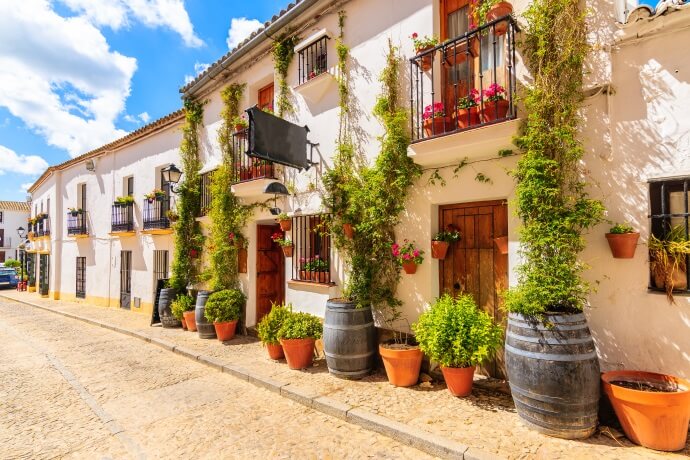
Nestled in the heart of the Sierra de Grazalema Natural Park, in the province of Cadiz, this village is surrounded by stunning natural landscapes, making it a haven for nature and adventure enthusiasts. This park is a UNESCO Biosphere Reserve, allowing visitors to discover hidden waterfalls, limestone caves, and panoramic viewpoints.
Make sure to visit the Church of San Juan, with its beautiful bell tower, as this is a notable landmark that dominates the village skyline. The Plaza de España, the main square of Grazalema, is a charming gathering spot lined with lovely cafes and surrounded by traditional whitewashed buildings. This town is also famous for its long history traditional crafts, such as the production of woolen goods and blankets.
Throughout the year, Grazalema celebrates various festivals and events that showcase its rich cultural heritage. The most outstanding is the Corpus Christi festival, held in June, where the streets are adorned with colorful flower petals and traditional processions take place.
Frigiliana
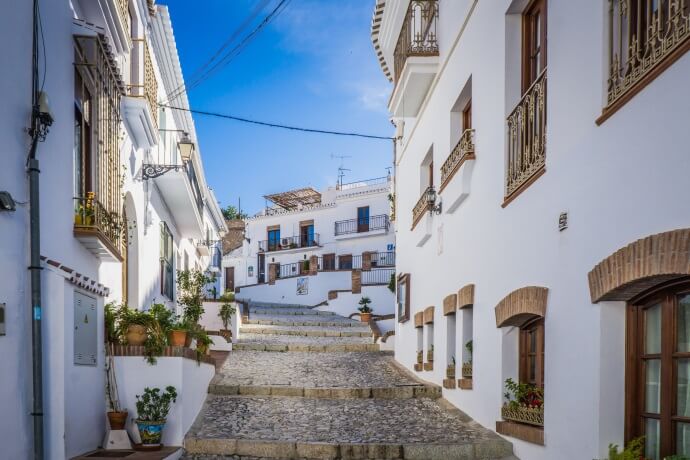
Perched on a hillside overlooking the Mediterranean Sea, this village located in the province of Málaga is widely regarded as one of the most beautiful villages in Spain, attracting visitors with its charming blend of traditional Andalusian architecture, rich history, and captivating natural surroundings.
The town's historical roots trace back to the Moorish period, and its layout and architecture still bear strong influences from that time, preserving its traditional Moorish character. The old town of Frigiliana is a maze of narrow, cobbled streets adorned with colorful pots of flowers, decorative tiles, and intricate ironwork. As you wander through the labyrinthine streets, you will discover hidden squares, charming courtyards, and stunning viewpoints that offer breathtaking views of the surrounding countryside and the Mediterranean Sea.
Frigiliana's main square, Plaza de la Iglesia, is a focal point of the village and home to the Church of San Antonio, a beautiful whitewashed religious building with a Mudejar-style bell tower. With an evident artistic spirit, you can observe local craftsmen creating pottery, ceramics, and woven goods. The village is situated at the edge of the Sierra de Almijara Natural Park, where you can hike and explore hidden waterfalls, scenic viewpoints, and an abundance of native flora and fauna.
Lanjarón
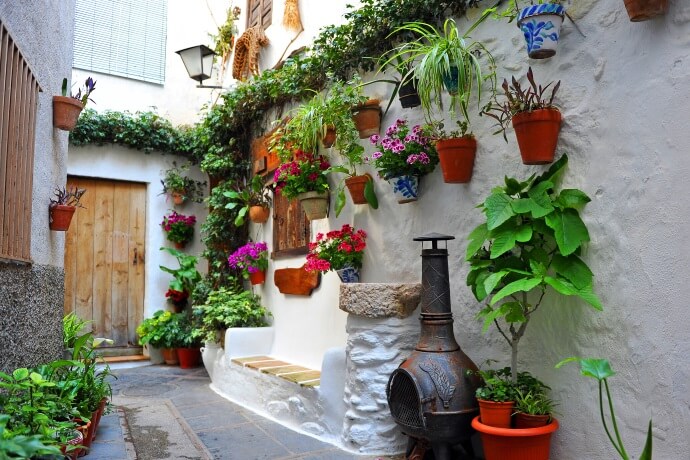
Located in the province of Granada, Lanjarón is sited at the foothills of the Sierra Nevada, famous for being home to Mulhacén, the highest peak on the Iberian Peninsula, offering beautiful sights of the mountain ranges around. One of the highlights of Lanjarón is its natural mineral water. The town's springs produce water that is renowned for its purity and medicinal properties, with a long-standing tradition of balneotherapy.
Strolling through the town’s center, you'll discover picturesque squares, cozy cafes, and local artisan shops selling handicrafts and products made from the local resources. As for historical sites, you must visit the Moorish Castle, perched on a hill overlooking the town, and the Church of the Incarnation, a beautiful 16th-century church.
During the annual Water Festival (Fiesta del Agua), held in June, the streets are transformed into a playful water fight zone, attracting many locals and tourists.
Antequera
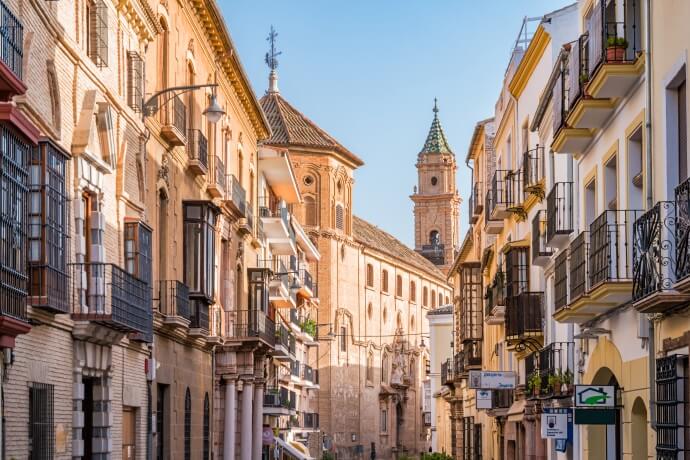
Known as the "Heart of Andalusia", Antequera is located in the province of Málaga. It has evidence of human settlement from the Bronze Age, and its strategic location has contributed to its rich history and cultural significance throughout the centuries. Antequera is surrounded by natural beauty with diverse landscapes, such as the nearby El Torcal Natural Park, which is a mesmerizing limestone formation.
One of the most iconic benchmarks in Antequera is the Alcazaba, an imposing Moorish fortress that sits atop a hill overlooking the town. Built during the 14th century, it provides panoramic views and a glimpse into the town's Islamic heritage. Another architectural gem is the Real Colegiata de Santa María la Mayor, a stunning Renaissance-style church.
The town also boasts an impressive collection of ancient dolmens, megalithic structures that are considered UNESCO World Heritage Sites. These dolmens, such as the Menga Dolmen and the Viera Dolmen, are believed to be burial chambers dating back over 5,000 years, making them among the oldest and largest megalithic structures in Europe.
Vejer de la Frontera
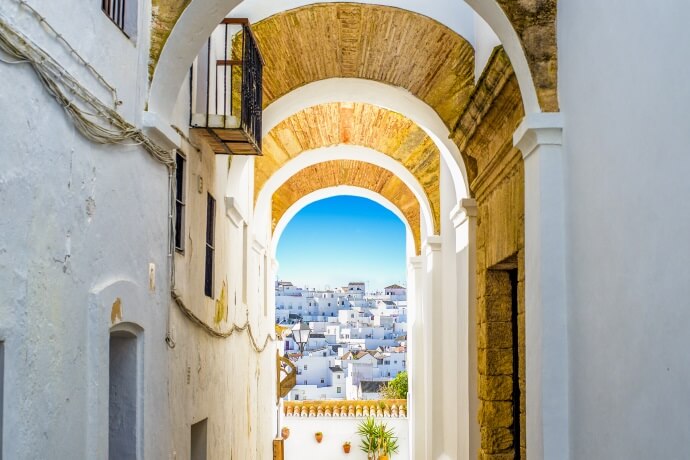
Surrounded by beautiful natural landscapes, Vejer de la Frontera, sited in Cadiz, is often regarded as one of the most beautiful Pueblos Blancos in Spain. The town's strategic location near the coast and the border with the Kingdom of Granada earned it the designation "de la Frontera" (meaning "of the border").
The town's history can be traced back to the Roman era, but it flourished during the Moorish occupation in the 8th century. The influence of Islamic culture can be seen in the narrow winding streets, whitewashed houses, and ornamental tile work that embellish the buildings. Walking through the streets of Vejer de la Frontera is like stepping back in time. The labyrinthine alleys, adorned with vibrant flowers and decorated balconies, lead you to hidden squares and quaint courtyards. The Plaza de España, the main square of the town, is a charming spot where locals and visitors gather to enjoy a cup of coffee or some delicious tapas.
Some of the historical spots that you must visit are the Castle of Vejer, a well-preserved fortress that dates back to the 10th century and showcases a fusion of Moorish, Gothic, and Renaissance architectural styles; and the 15th-century Church of the Divine Savior (Iglesia del Divino Salvador), built on the site of a former mosque and boasting a stunning Mudéjar-style tower with an exquisite interior.
Zahara de la Sierra
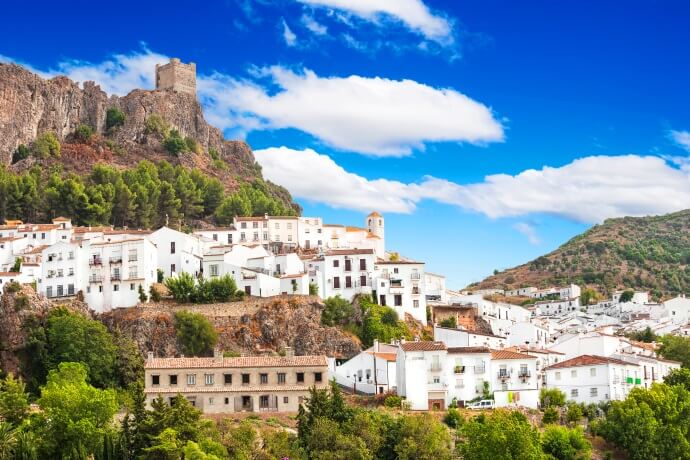
Nestled in the Sierra de Grazalema Natural Park, in Cadiz, Zahara de la Sierra is a charming and picturesque village characterized by its whitewashed houses that cascade beautifully down the hillside, creating a striking contrast against the natural backdrop of the mountains and the turquoise waters of the Zahara-El Gastor Reservoir. The panoramic views from Zahara de la Sierra are simply out of this world.
Zahara de la Sierra is steeped in history and has a fascinating Moorish past. The town's main landmark is the 13th-century Moorish Castle, perched atop the hill. The town's narrow streets wind their way through the old quarter, revealing charming corners, whitewashed houses with flower-filled balconies, and traditional Andalusian architecture. The 16th-century Church of Santa María de la Mesa is another notable attraction, showcasing a blend of Gothic and Mudéjar architectural styles.
Zahara de la Sierra hosts the lively Feria Real, a traditional fair that showcases Andalusian music, dance, and gastronomy. The village's traditional cuisine features regional specialties such as "cazuela de venado" (venison stew) and "gazpacho serrano" (a hearty soup).
Mijas
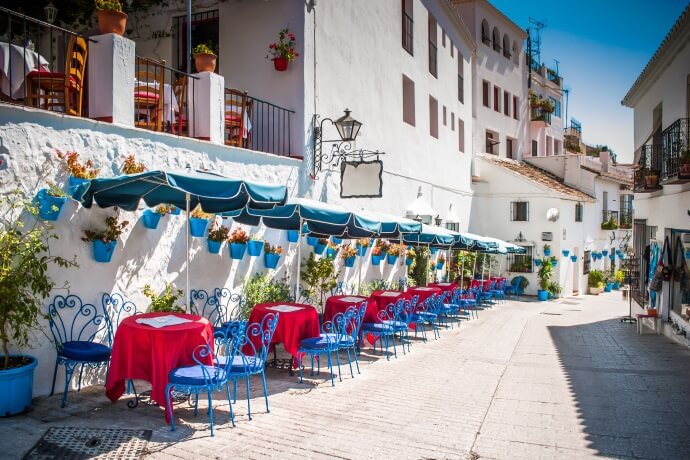
Situated on the Costa del Sol, Málaga, this lovely white-washed village combines traditional charm with spectacular natural surroundings, boasting a relaxed Mediterranean lifestyle. The town is divided into three distinct areas: Mijas Pueblo, the historic village; Mijas Costa, the coastal area; and La Cala, a former fishing village that has developed into a vibrant resort. Each area has its own unique characteristics, adding to the diversity and appeal of Mijas as a whole.
Mijas Pueblo, the old town, is the heart and soul of the municipality. Its narrow, cobbled streets are lined with traditional whitewashed houses adorned with colorful flower pots, creating a picturesque setting. The central square, Plaza de la Constitución, is a bustling hub where locals and visitors gather to relax at sidewalk cafes and admire the iconic donkey taxis, a charming symbol of Mijas. Make sure you stop at the 17th-century Church of San Sebastián, which stands prominently in the main square. The town also houses various stunning art galleries.
The coastal area of Mijas, known as Mijas Costa, stretches along the Mediterranean Sea and offers beautiful beaches, such as La Cala Beach and Calahonda Beach. La Cala, once a small fishing village, has now been transformed into a bustling resort, famous for its Friday market, where you can explore stalls selling local produce, crafts, and souvenirs.
Capileira

Capileira is a pretty village located in the Alpujarra region of the province of Granada. Situated on the southern slopes of the Sierra Nevada mountains, its splendid natural surroundings and rich cultural heritage make it a popular destination for travelers seeking a peaceful mountain retreat. Here, you can embark on a scenic hike to the Poqueira Ravine, a deep gorge that showcases the impressive beauty of the area.
The village of Capileira is nestled at an elevation of over 1,400 meters (4,600 feet), offering breathtaking views of the rugged mountain peaks and the fertile valleys below. Exploring the village on foot is a delight, as you can wander through its labyrinthine alleys, lined with craft shops, local artisan workshops, and cozy cafes. Capileira exudes the tranquil way of life of the Alpujarra region and is famous for its handmade rugs and textiles, woven using ancient techniques passed down through generations.
The gastronomy of Capileira showcases the agricultural abundance of the Alpujarra, with fresh fruits, vegetables, and aromatic herbs playing a prominent role in the local cuisine, and the most famous event is the Fiesta de Moros y Cristianos (Festival of Moors and Christians), a colorful and lively reenactment of the historic battles between the two groups that shaped the history of the region.
Setenil de las Bodegas
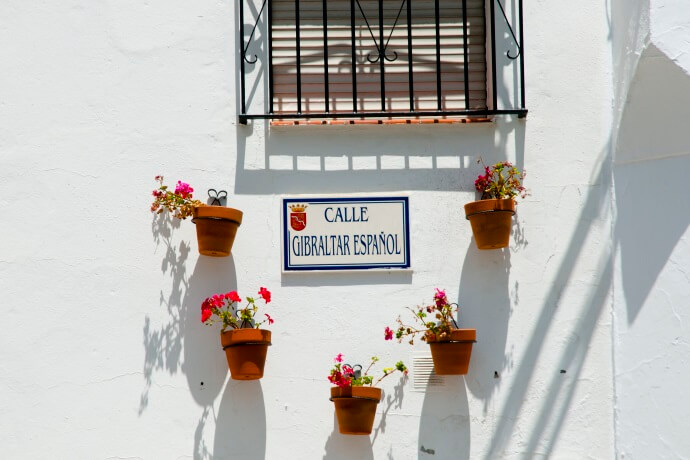
Sited in Cadiz, what sets Setenil de las Bodegas apart from the other Pueblos Blancos is its fascinating integration with the natural landscape, as many of its houses and streets are built into the surrounding cliffs and rock formations. The village stretches along the Trejo River, with the striking Ronda-Setenil road passing through it. The narrow and winding streets are lined with buildings that have adapted to the rock formations, creating a fascinating labyrinth of arches, nooks, and crannies in this stunning hidden world. The irregularity of the buildings and the play of light and shadow make every corner a delight to explore.
The village's name, "Setenil", is derived from the Latin "septem nihil", meaning "seven times no". Legend has it that during the Moorish occupation, the Christian troops tried to conquer the village seven times but were unsuccessful.
While there, make sure to visit the Church of Nuestra Señora de la Encarnación, located in the heart of the village, as this is a beautiful example of the Andalusian religious architecture.
Just like its neighbors, Setenil de las Bodegas hosts various cultural events and festivals that celebrate its rich history and traditions. One of the most prominent is the Semana Santa (Holy Week) processions, where religious statues are paraded through the streets, accompanied by music and local traditions.
Ronda
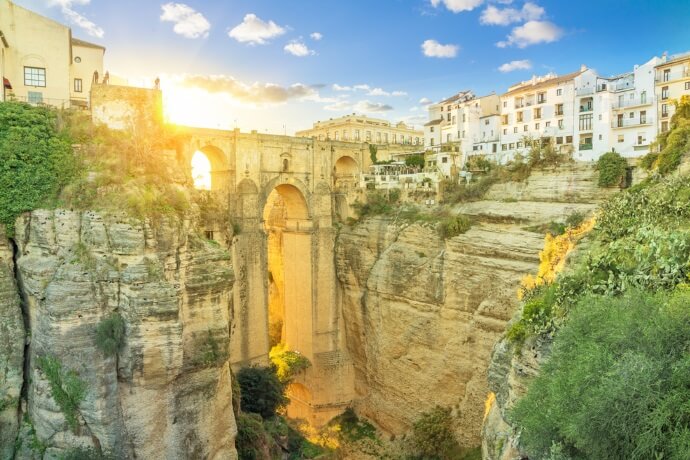
Ronda is a captivating town located in the province of Málaga. It is suspended atop the El Tajo gorge, which divides the town into two sections: the historic old town (La Ciudad) and the newer part (El Mercadillo). Nearby, you can explore the beautiful Sierra de las Nieves Natural Park, a UNESCO Biosphere Reserve known for its diverse flora and fauna.
One of the most iconic landmarks in Ronda is the Puente Nuevo, or New Bridge. This magnificent bridge is an architectural marvel where you can admire the fabulous panoramic views. Make sure to stop and explore the Casa del Rey Moro (House of the Moorish King), a fascinating historical site that includes beautiful gardens and a staircase carved into the rock. The impressive 16th-century Puente Viejo (or Old Bridge), provides another great point to admire the gorge.
The town boasts several impressive churches, such the Church of La Merced, known for its intricately designed façade. Ronda has attracted many prominent writers and artists over the years, including Ernest Hemingway, who famously depicted this wonderful town in his novel "For Whom the Bell Tolls”.
Olvera
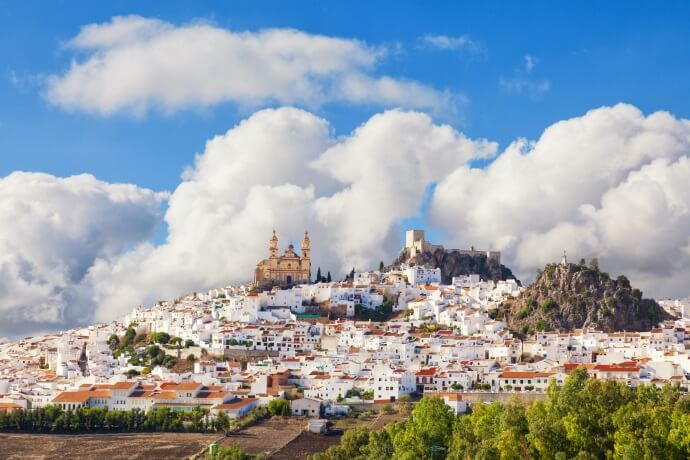
Situated on a hilltop in the Sierra de Cadiz region, Olvera is steeped in history, with traces of human settlement dating back to prehistoric times.
The town's historic quarter, known as the Old Town, is a maze of narrow, winding streets lined with whitewashed houses and adorned with colorful flower pots. The Church of Nuestra Señora de la Encarnación, with its ornate façade and beautiful interior, is a notable landmark in the Old Town. However, the centerpiece of Olvera is its magnificent 12th-century Moorish castle, known as the Castle of Olvera or La Muela, which allows you to admire the panoramic views of the town and the Guadalporcún River Valley.
A popular spot for visitors to capture memorable photos and experience the town's romantic charm is the Callejón (or "Alley of the Kiss"). This narrow alley connects two streets, and its buildings are so close together that people leaning out of the windows can reach out and kiss.
The surrounding natural landscapes of Olvera are equally captivating, as the town is located in the Sierra de Grazalema Natural Park, a UNESCO Biosphere Reserve.
The Most Beautiful Tale
The Pueblos Blancos are splendid Spanish villages that when pieced together write the most beautiful tale of timeless beauty steeped in history. As you wander through their narrow streets, glimpses of a dramatic past emerge at every turn you take in these stunning white-washed towns with dots of colorful flowers, creating a romantic and picturesque scenario just for you to get lost in.



